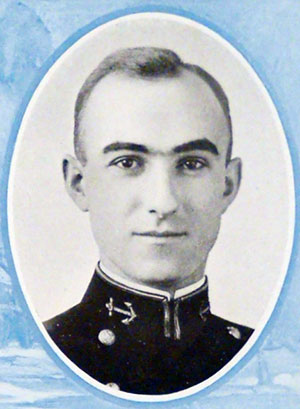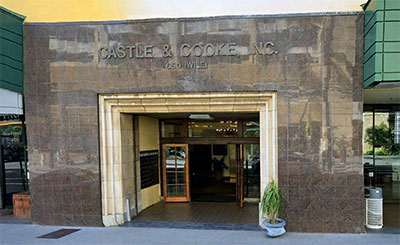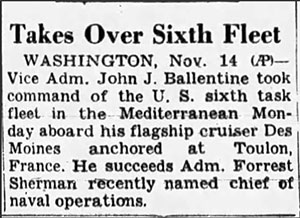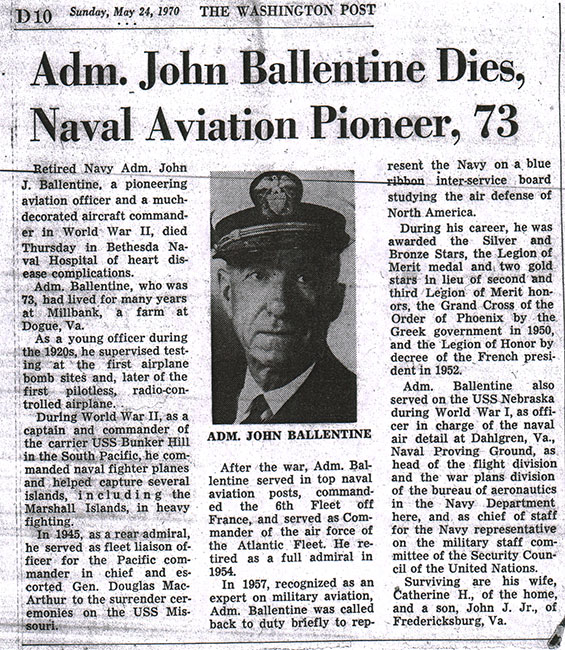|
John Ballentine was a third-generation American, his paternal grandfather having been born in Scotland. The 1900 U.S. Census placed him at age three in Ohio on a farm in Washington township. His father was a farmer. He lived with his parents and an older sister, Georgiana, nine. The 1910 Census recorded the family in similar conditions.
He joined the Navy in June 1914 as documented in the following record from the official roster of Ohio soldiers in WWI. He attended the Naval Academy, graduated in 1917 and remained a reserve officer until 1919. He served on the battleship U.S.S. Nebraska during WWI.
Roster of Ohio Soldiers in WWI (Source: ancestry.com)
 |
In 1920 he completed flight training at Pensacola, FL and embarked on a career in naval aviation.
John Ballentine, Date Unknown (Source: ancestry.com)
 |
In 1920, the Census captured Ballentine at home with his parents at 136 Main Street, Hillsboro, OH. His sister had moved on, and his occupation was coded as "Naval Officer." His marital status was single.
After the Census, in 1922, he married Catherine Howard Sheild [sic] Ballentine
(1900-1981). They had two sons, John Jr. (1923-2007) and Howard S. (1929), who died in infancy.
He took advanced flight training with the army in Texas and in Florida. He was then assigned to duty with the navy's first torpedo plane squadron at Yorktown, VA. After that he was assigned in 1924 to the Naval Air Detail Proving Ground at Dahlgren, VA (see news article, below, right). There he was tasked with putting the Norden bombsight, invented in 1923, through its original tests. There also, according to his retirement documentation, in 1924, he controlled, from the ground, the first airplane ever to take off and land under radio control in the U.S.
Soon he was assigned to the Asiatic Fleet and made at least two special trips to Tokyo to form a general impression of Japanese naval aviation. He reported at the time, "They are much stronger than credited by our Navy department and will stand watching."
As an aside, but perhaps related to his Asiatic Fleet assignment, a U.S. immigration form dated June 7, 1928 documented his travel alone aboard the Navy ship S.S President Grant (later wrecked southeast of New Guinea in 1944) from Yokohama, Japan to Honolulu, T.H. No information on the form suggested a purpose for his travel. He gave his address in Hawaii as 408 Castle and Cooke Building. Castle and Cooke are still a going concern in Honolulu, as the photograph below shows. The present day building does not appear to be 1920s vintage, although the facade pictured might be.
Castle and Cooke Building, Honolulu (Source: Google Earth)
 |
For the 1930 Census, he was located at the Naval Proving Ground at Dahlgren, about 40 south of Washington, DC. Catherine and son, John were with him. They rented their living space for $80 per month.
Hillsboro (OH) Press- Gazette, September 22,1944 (Source: newspapers.com)
 |
Ballentine landed once and signed the Tucson Register on May 31, 1935 at 3:00 PM. He was solo in the Boeing F2B-1 he identified as "1658." Based at Washington, DC, he was westbound from Washington and departed the same day to San Diego, CA. A search of Joe Baugher's site came up dry for that number, either by registration of serial number. The San Diego, CA city directory for 1937 recorded the family living at 639 Adella Avenue, Coronado, CA. That address today is among neatly maintained homes with swimming pools.
Indeed, he was assigned for a time during the 1930s to the Bureau of Aeronautics in DC. The 1940 Census located him and his family at 3405 O Street in Washington, DC, about a 3-mile car ride to the Pentagon. His occupation was coded as "Commander" in the U.S. Navy. A servant, Annie Burrell, lived with them.
During WWII Ballentine moved up through the ranks. At the start of the war, he was executive officer of the aircraft carrier U.S.S. Ranger. He then assumed command of the Navy's first "baby flat top," the U.S.S. Long Island. In 1943, he was assigned to the Bethlemem Steel Corp., Quincy, MA, to ovesee the fitting of the aircraft carrier Bunker Hill.
The article, right, from the Hillsboro (OH) Press- Gazette, September 22,1944 describes some of his exploits, including the reason why he was living at the naval proving ground at Dahlgren, VA back in 1930. As well, he covered a lot of ocean during the war in command of aircraft carriers as a Rear Admiral.
Salt Lake City Tribune, November 15, 1949 (Source: newspapers.com)
 |
Shortly after WWII, the Salt Lake City Tribune, November 15, 1949 reported his assignment to the Mediterranean to take over the U.S. Sixth Fleet, left.
Part of his duties while there were reported, below, in the Hillsboro (OH) News-Herald, January 18, 1951, which described a visit to his flagship, the U.S.S. Des Moines, by King Paul and Queen Frederica of Greece. His rank had moved up to Vice Admiral.
Hillsboro (OH) News-Herald, January 18, 1951 (Source: newspapers.com)
 |
The abbreviated snip from that much longer article at left informs us that one guest at some of the formalities was his son, John J. Ballentine, Jr. who would have been about 28 years old in 1951.Of interest are some of the other guests at one of the luncheons: Captain Frederick Trapnell was a significant player in developing carrier-based aviation.
Ballentine retired from the navy May 1, 1954 at age 57 after 40 years of service. His retirement was reported in his local Hillsboro Press-Gazette on May 7,1954. He retired as a full admiral commanding the U.S. Atlantic Fleet at Norfolk, VA. Ceremonies were held aboard the U.S.S. Hornet there.
For further information, his papers and other records related to his service after 1920 are archived at the Library of Congress (LOC) at the link. The LOC description reads as follows.
Library of Congress Holdings From J.J. Ballentine (Source: LOC)
| Correspondence, memoranda, diaries, logbooks, military records, biographical materials, scrapbooks, clippings, photographs, and other papers relating primarily to Ballentine's naval career after 1920. Documents Ballentine's training as an air pilot; his duties at the Naval Proving Ground, Dahlgren, Va., including the testing of the Norden bombsight and the first remote-controlled airplane; his correspondence with Theodore H. Barth, president of Carl L. Norden, Inc., relating to the testing and production of Norden bombsights; his activities during World War II off the coast of North Africa during Operation Torch (1942) and as first commanding officer of the Bunker Hill (aircraft carrier) in campaigns in the Pacific Ocean (1943-1944); his postwar tours of duty in the Mediterranean as commander of Carrier Division One (1947-1949) and as commander of the Sixth Fleet (1949-1951); his tour of duty (1951-1954) as Commander Air Force Atlantic Fleet (COMAIRLANT); his activities as a member of a U.S. armed forces interservice board in Washington, D.C. (1956-1957); and his lifelong interest in hunting. Correspondence received as COMAIRLANT includes reports from commanders in the Mediterranean and information on the Korean War. Includes histories of U.S. naval aviation. |
Born October 4, 1896 in Hillsboro, OH, Ballentine flew West May 21, 1970 (age 73). His obituary from the Washington Post is below.
J.J. Ballentine Obituary, Washingon Post, May 24, 1970 (Source: NASM)
 |
Dossier 2.2.24
---o0o---
THIS PAGE UPLOADED: 02/22/20 REVISED:
|








